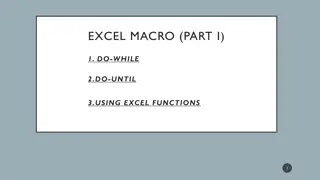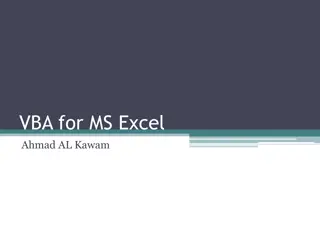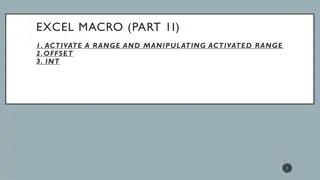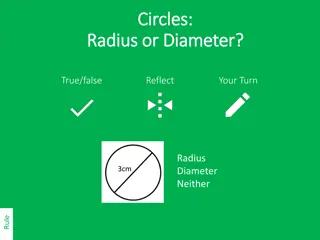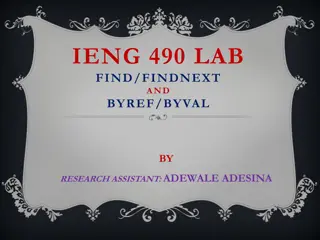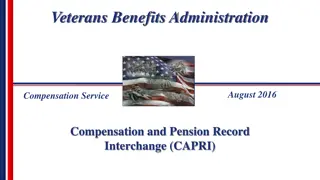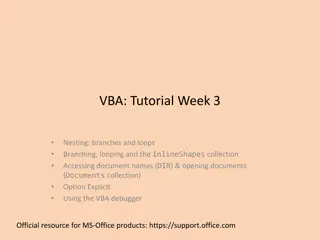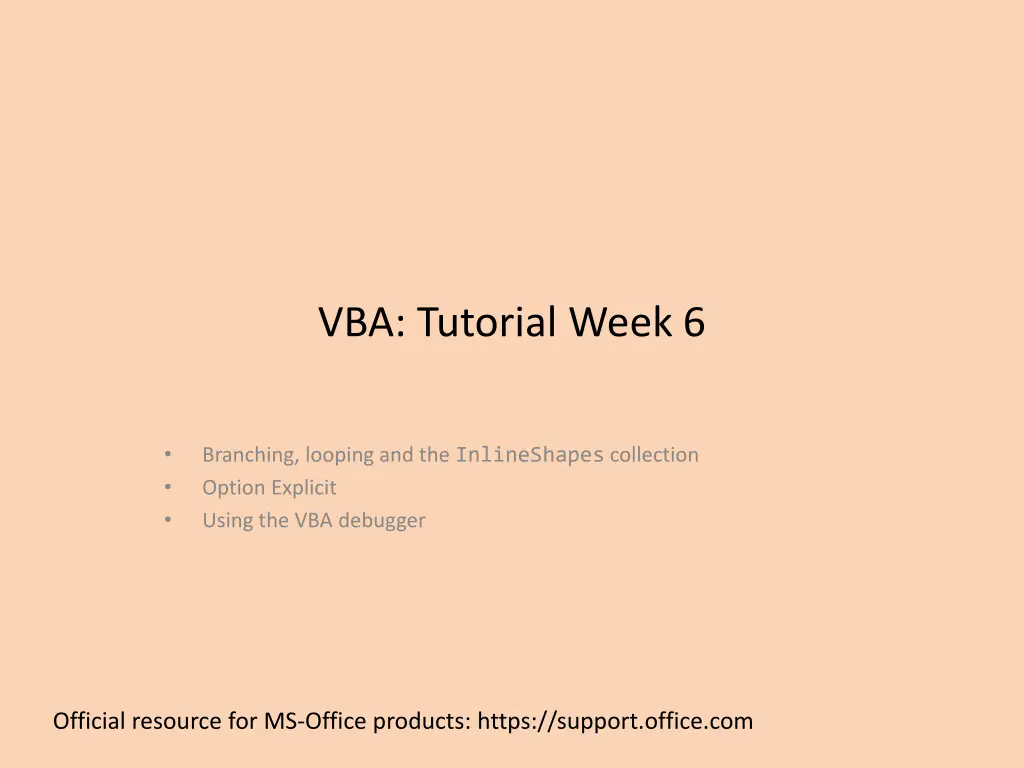
VBA Tutorial Week 6: Branching, Looping, and Collections Overview
Explore branching and looping structures in VBA, learn to work with InlineShapes collections, and understand how to access and manipulate items in collections. Get valuable resources and guidance to enhance your MS Office VBA skills.
Download Presentation

Please find below an Image/Link to download the presentation.
The content on the website is provided AS IS for your information and personal use only. It may not be sold, licensed, or shared on other websites without obtaining consent from the author. If you encounter any issues during the download, it is possible that the publisher has removed the file from their server.
You are allowed to download the files provided on this website for personal or commercial use, subject to the condition that they are used lawfully. All files are the property of their respective owners.
The content on the website is provided AS IS for your information and personal use only. It may not be sold, licensed, or shared on other websites without obtaining consent from the author.
E N D
Presentation Transcript
VBA: Tutorial Week 6 Branching, looping and the InlineShapes collection Option Explicit Using the VBA debugger Official resource for MS-Office products: https://support.office.com
Microsoft Introduction/Overview Of VBA https://docs.microsoft.com/en-us/office/vba/library- reference/concepts/getting-started-with-vba-in-office VBA tutorial notes by James Tam
Activities In Tutorial TA demos: Used for more complex features (typically multiple steps are required). The tutorial instructor will show on the projector/instructor computer each step for running the feature in Excel. Unless otherwise specified the tutorial material will take the form of a TA demonstrating the use of features in Excel. Slides titled Lecture Review are covered for the second time and dealing with less complex material. For this reason they will only be covered briefly in tutorial. Student exercises: Used instead of TA demos for simpler features. You will have already been given a summary of how to invoke the feature and the purpose of the exercise is to give you a chance to try it out and get help if needed. VBA tutorial notes by James Tam
Return To Collections Recall with the collections you have seen: Documents, InlineShapes, Shapes, Tables you can access a particular element or item in the collection by that item s index. Example (accesses the first InlineShape): ActiveDocument.InlineShapes(1) Also the number of items in the collection can be accessed through the collection s count attribute. Example (the variable numTables will contain the current number of tables in the currently active Word document): numTables = ActiveDocument.Tables.count VBA tutorial notes by James Tam
Return To Collections (2) Now that you have learned how to use looping and branching structures, you can: Access each item in a collection (using a loop). Check if the number of items in the collection is the desired amount (using a branch). VBA tutorial notes by James Tam
Collections: Inline Shapes Example program: 1_loop_branch_inline_shapes For documents containing 2 - 4 InlineShapes (images) the program will halve the size of odd numbered images. Sub reduceOddInlineShapes() Const MIN_SHAPES As Long = 2 Const MAX_SHAPES As Long = 4 Dim count As Long Dim numShapes As Long Dim tempWidth As Long numShapes = ActiveDocument.InlineShapes.count If ((numShapes < MIN_SHAPES) Or (numShapes > MAX_SHAPES)) Then MsgBox ("Number of Inline Shapes not " & MIN_SHAPES & _ "-" & MAX_SHAPES) VBA tutorial notes by James Tam
Collections: Inline Shapes (2) Else count = 1 Do While (count <= numShapes) If ((count Mod 2) = 0) Then tempWidth = ActiveDocument.InlineShapes(count).Width / 2 ActiveDocument.InlineShapes(count).Width = tempWidth End If count = count + 1 Loop End If End Sub VBA tutorial notes by James Tam
Student Exercise 1 Write a program that will prompt the user for a positive integer value (1 or greater). The program will then double the size of the item # of the Inline Shape in the currently active document. Name of the document containing the solution: 1_enlarge_A_pic_solution VBA tutorial notes by James Tam
Student Exercise 4 Modify the solution to the previous exercise so that the program error checks the user s input. If the value enter by the user is less than 1 or it exceeds the current number of In line shapes in the document: The program will display an error message specifying the correct range of values that can be entered (it needs to be based on the actual number of shapes in the currently active document). The program will repeat the prompt until a value within the correct range has been entered. Name of the document containing the solution: 2_enlarge_A_pic_solutionV2 VBA tutorial notes by James Tam
Counting Occurrences Of A Word It s an application of the Find method of the ActiveDocument object combined with looping. Why count occurrences: Evaluating resumes by matching skills sought vs. skills listed by the applicant. Ranking the relevance of a paper vs. a search topic by the number of times that the topic is mentioned. Word frequency may be one criteria employed when websites rank search results according to relevance VBA tutorial notes by James Tam
Checking Occurrences Word document containing the macro (actually it checks if word is or isn t found rather than doing an actual count but a small modification will allow a count to be performed): 2_determine_if_word_occurs Sub checkingOccurence() Dim occurs As Boolean Dim searchWord As String searchWord = InputBox("Word to search for") occurs = False With ActiveDocument.Content.Find Do While .Execute(FindText:=searchWord, Forward:=True, _ MatchWholeWord:=True) = True occurs = True 'Word was found change state Loop End With VBA tutorial notes by James Tam
True: search for exact word False: partial match counted e.g. when looking for the words like there are counted Search not started, assume Word not in document Checking Occurrences Word document containing the macro (actually it checks if word is or isn t found rather than doing an actual count but a small modification will allow a count to be performed): 2_determine_if_word_occurs Sub checkingOccurence() Dim occurs As Boolean Dim searchWord As String searchWord = InputBox("Word to search for") occurs = False With ActiveDocument.Content.Find Do While .Execute(FindText:=searchWord, Forward:=True, _ MatchWholeWord:=True) = True occurs = True Loop End With Word to find in document Body of Do-While entered when a match occurs (in this case can set variable to indicate that it s true that word was found) VBA tutorial notes by James Tam
Checking Occurrences Once the search is complete display the results of the search If (occurs = True) Then MsgBox ("'" & searchWord & "'" & " was found") Else MsgBox ("'" & searchWord & "'" & " could not be found") End If End Sub VBA tutorial notes by James Tam
Student Exercise 3 Modify the previous program. Instead of determining if the search word was or was not found have your program count the number of occurrences. A word should be counted if it s a partial match e.g. when search for the the words the , their , they re and there should all be counted. After the search is complete the number of occurrences should be displayed in a popup Name of the document containing the solution: 3_count_occurences.docm Example data used to test the correctness of your solution. Search for the , count should be 2 Search for at , count should be 2 Search for t , count should be 4 VBA tutorial notes by James Tam
Option Explicit Used Including Option Explicit requires that variables must be created via Dim variable declaration E.g. Dim tamMoney As Long After creating/declaring the variable the memory location can be used by assigning a value into that location. E.g. tamMoney = 1 Advantage: helps catch bugs If you type in the wrong variable name if you use Option Explicit then VBA may tell you exactly where the error lies. tamMoney 1 VBA tutorial notes by James Tam
VBA will automatically catch the error and point out the location Example: Option Explicit Used Example: 3A_optionExplicitUsed.docm VBA tutorial notes by James Tam
Example: Option Explicit Not Used Example: 3B_optionExplicitNotUsed.docm Sub lotteryProgram2() Dim tamMoney As Long Dim dieRoll As Long tamMoney = 1 dieRoll = CInt(Int((6 * Rnd()) + 1)) If (dieRoll >= 1) And (dieRoll <= 4) Then tamMooney = 1000000 End If MsgBox ("Tam's income $" & tamMoney) End Sub Tam didn t get the big bucks Errors like this can be hard to catch/fix in all but smallest programs The program erroneously set the wrong variable! VBA tutorial notes by James Tam
A More Complex But Practical Example Example: 4_set_fill_color_for_all_documents_in_a_folder.docm (The file name describes exact what this program does). Sub setFillAllFolderDocuments() Const ERROR_MESSAGE As String = "No shapes in document to fill" Dim location As String Dim currentDocumentName As String Dim fullname As String Dim currentShape As Long Dim numShapes As Long location = "" currentDocumentName = "" VBA tutorial notes by James Tam
A More Complex But Practical Example (2) 'Check if user didn't enter any location Do While (location = "") location = InputBox("Enter path to Word documents " & _ "(e.g. C:\temp): ") If (location = "") Then MsgBox ("You entered '" & location & _ "', don't enter an empty location") End If Loop VBA tutorial notes by James Tam
A More Complex But Practical Example (3) 'Separator between last containing folder and filename location = location & "\" 'Only consider and open Word (2003 or 2007+) documents currentDocumentName = Dir(location & "*.doc*") 'Check if program is unable to find Word documents in location If (currentDocumentName = "") Then MsgBox ("Unable to retreive any docs in the " & _ "specified location") VBA tutorial notes by James Tam
A More Complex But Practical Example (4) 'Folder contains at least one Word document Else 'Loop executes so long as there is another Word document 'that hasn't already been accessed Do While (currentDocumentName <> "") fullname = location & currentDocumentName Documents.Open (fullname) numShapes = ActiveDocument.Shapes.Count 'No shapes write error message If (numShapes = 0) Then Selection.Font.Bold = True Selection.Font.ColorIndex = wdRed Selection.Font.Size = 24 Selection.TypeText (ERROR_MESSAGE) VBA tutorial notes by James Tam
A More Complex But Practical Example (5) 'Document has shapes Else 'Starting with first shape so long as there's another 'shape in document repeat loop currentShape = 1 Do While (currentShape <= numShapes) ActiveDocument.Shapes(currentShape).Fill.ForeColor = vbRed 'Move onto next shape currentShape = currentShape + 1 Loop 'Goes through each shape in current doc End If 'Checks if any shapes in current doc 'Automatically save and close document, move onto next ActiveDocument.Close (wdSaveChanges) currentDocumentName = Dir Loop 'Goes through each Word doc End If 'Checks if any Word docs in folder VBA tutorial notes by James Tam
The VBA Debugger Debuggers can be used to help find errors in your program Setting up breakpoints Points in the program that will pause until you proceed to the next step Useful in different situations The program crashes but you don t know where it is occurring Pause before the crash An incorrect result is produced but where is the calculation wrong Set up breakpoints Click in the left margin VBA tutorial notes by James Tam
The VBA Debugger (2) Multiple breakpoints Program pauses when breakpoints are reached The contents of variables can be displayed at that point in the program VBA tutorial notes by James Tam
The VBA Debugger (3) Combining breakpoints and viewing variables. VBA tutorial notes by James Tam
An Example To Run With The Debugger Example: 5_debuggerExample.docm Sub: DebuggingExample1 Set up a breakpoint and trace through the program step-by- step while viewing the contents of the loop control during each iteration of the loop VBA tutorial notes by James Tam
An Example To Run With The Debugger (2) Program randomly assigns value into x, y, z (1 100) Set up multiple breakpoints and mouse over variables at the breakpoints to view their contents. This time x = 71, y = 54, z = 1 Which branches execute What values will be assigned to the string s Example (cont ): 5_debuggerExample.docm Sub: DebuggingExample2 VBA tutorial notes by James Tam
Open Tutorial No new teaching will occur but the TA will be available for help. During this "Open Tutorial" Any CPSC 203 student can ask for help and not just the students who are registered in a particular tutorial. The purpose is to provide extra help. VBA tutorial notes by James Tam









